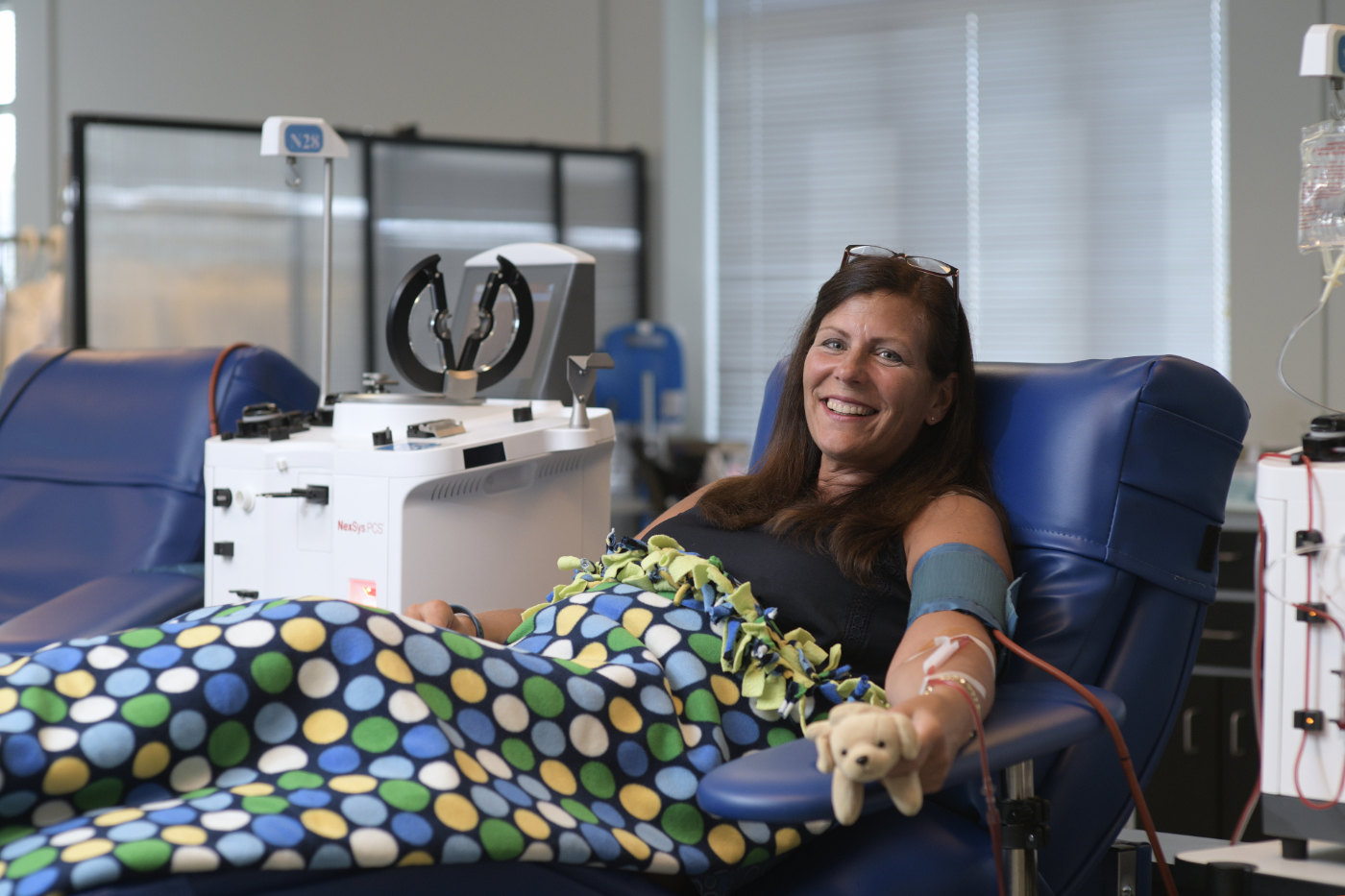Category: Tips for donors
Tips for donors
What to eat before donating plasma
Tips for donors
What to eat before donating plasma
April 26, 2024
Congratulations, you’re on the road to donating plasma! Donating plasma is a noble act that can save lives, but it’s essential to prepare your body adequately for the donation process. Proper nutrition plays a crucial role in ensuring a safe and comfortable plasma donation experience. In this guide, we’ll cover what to eat for breakfast before donating plasma, what not to eat, and what to eat in general before your plasma donation appointment.
What to eat for breakfast before donating plasma
Congratulations, you’re on the road to donating plasma! Donating plasma is a noble act that can save lives, but it’s essential to prepare your body adequately for the donation process. Proper nutrition plays a crucial role in ensuring a safe and comfortable plasma donation experience. In this guide, we’ll cover what to eat for breakfast before donating plasma, what not to eat, and what to eat in general before your plasma donation appointment.
What to eat for breakfast before donating plasma
As the saying goes, breakfast is the most important meal of the day. This adage is even truer when it comes to donating plasma! A nutritious breakfast can help stabilize your blood sugar levels, keep you energized, and minimize the risk of complications during plasma donation. Here are some breakfast options to consider:
1. Whole grains: Whole grain toast or oatmeal are excellent choices. They provide sustained energy and fiber to keep you feeling full.
2. Protein: Include lean sources of protein such as eggs, yogurt, or peanut butter. Protein helps maintain muscle strength and overall health.
3. Fruits: Opt for fresh fruits like bananas, apples, or berries. They provide vitamins and natural sugars for a quick energy boost.
4. Beverages: Though it may be hard to sacrifice your morning coffee or tea, it is best to limit your intake of caffeine before a plasma donation as it can lead to dehydration. Start your day with a glass of water or juice to stay hydrated.
What not to eat before donating plasma
Certain foods and beverages can affect the quality of your plasma and your overall well-being during the plasma donation process. Here’s what to avoid:
1. Fatty snacks and treats prior to your donation. These foods can have a negative impact on blood tests, potentially preventing you from donating.
2. Fasting before your donation. It is important you’ve eaten a healthy meal within a few hours before your donation.
3. Fatty foods to avoid include but are not limited to:
- Sweets/candy
- Burgers
- Potato chips
- Pizza
- French fries
- Ice cream
Remember that healthy fats are okay. These include avocado, fatty fish, eggs, nuts, cheese, and full-fat yogurt.
4. Avoid drinking alcohol for 24 hours before your plasma donation. Alcohol can lead to dehydration, making it difficult for you to donate.
What to eat and drink before a plasma donation
- Eat a protein and iron-rich meal no more than a few hours before your donation. You do not want an empty stomach! Protein-rich foods include but are not limited to
- Yogurt
- Chicken
- Eggs
- Beef
- Cheese
- Nuts
- Seeds
- Beans
- Iron-rich foods include but are not limited to:
- Chicken
- Ham
- Beef
- Certain breakfast cereals
- Beans
- Watermelon
- Turkey
- Broccoli & leafy greens
2. Much like with food, what you drink is an essential factor in the overall health of your blood plasma. Drink plenty of water before and after donating. Drinking water is so important because it directly affects how full your vein is and how your plasma is separated. Make sure you have plenty of H2O in the 12 hours before and after your donation.
Extra tips to prepare for your plasma donation
Though nutrition is key to improving your plasma donation, here are a few extra things you can do to make your experience even more comfortable:
1. Get a good night’s sleep before donating your plasma, as it’ll allow for a quicker recovery and a more plentiful donation.
2. Ensure your sleeves can be pushed up so the center team can easily access the veins in your arms.
3. Consider bringing a light sweater to keep warm during the donation process.
4. Bring any personal items that will help you feel as relaxed and comfortable as possible.
5. Pack your phone, a book, or headphones to help pass the time. (All KEDPLASMA centers have free WiFi!)
Following these tips and keeping yourself healthy will make you eligible to donate plasma and save lives. At KEDPLASMA, our donors are our priority, and we thank you for your continued contributions. We have 70 locations nationwide, find your closest center here.
FAQs
Tips for donors
Temporary deferrals and plasma donation: everything you need to know
Tips for donors
Temporary deferrals and plasma donation: everything you need to know
April 10, 2024
Plasma donation plays a crucial role in providing life-saving medical treatments for a variety of conditions. That’s why donating is an important and generous act. As a donor or an aspiring one, you may have heard about temporary deferrals, a necessary aspect of the donation process that ensures your health and safety as well as the one of your plasma recipient. Most deferrals are temporary. So don’t worry if you have been deferred; you will soon be able to donate again!
6 common reasons for temporary deferral
1. Recent illness
If you have recently been ill or are currently experiencing symptoms of illness (cold, flu, COVID-19, sore throat, for example), you may be temporarily deferred. This precaution prevents the spread of infection and ensures both your well-being and the one of the recipients of your plasma donation. That’s why it’s important to refrain from donating until you’ve fully recovered.
2. Tattoos
If you got a tattoo within the last 3-6 months, you may be ineligible to donate plasma. The waiting period typically depends on how long it takes for the tattoo to heal fully. The reason behind this deferral is that needles, especially if unclean, can carry bloodborne illnesses that may not be immediately detectable when your blood gets tested.
3. Medication, surgery, and medical procedure
If you are on medication but still want to donate plasma, consult the medical staff at your center. Certain medications, such as antibiotics or antidepressants, and some vaccines may not be compatible with the donation process, necessitating a temporary suspension. Additionally, some pain medications can affect platelet counts; however, you can donate plasma if you stop taking them 48 hours prior to your appointment. If you’ve recently undergone surgery or specific medical procedures, including dental work, you may be temporarily deferred to allow time for your recovery and to ensure your overall well-being before you resume donation activities.
4. Anemia and iron levels
If the hemoglobin test reveals that your hemoglobin level is lower than normal, it means you have a low red blood cell count. Anemia could therefore be a reason for temporary exclusion from donation. If you are a woman, your hemoglobin level must be at least 12.5 g/dL; for men, the minimum level is 13.0 g/dL. Below these values, you will not be able to donate. Low iron levels can also lead to a temporary deferral because insufficient levels may impact your well-being.
5. Pregnancy or recent childbirth
Being pregnant or having recently given birth can be another reason for your temporary deferral. Don’t worry! It’s a temporary condition that allows you time for recovery and protects your health and the one of your newborn.
6. Travels to high-risk areas
Have you recently traveled to regions with a high prevalence of infectious diseases (particularly those transmitted through blood)? Talk with your donation center because that could lead to a temporary deferral.
Temporary deferrals are a fundamental aspect of the plasma donation process, reflecting the commitment of donation centers to maintain high standards of safety and quality. As donors generously contribute to the well-being of others, understanding and respecting temporary deferrals contributes to the overall success of plasma donation programs. By working with donation centers and following established guidelines, you play a vital role in advancing medical treatments and improving the lives of individuals around the world.
Tips for donors
How to improve plasma donation eligibility
Tips for donors
How to improve plasma donation eligibility
In its various forms, donation is an expression of reciprocity and solidarity. Each of us can help improve the lives of others by saying “yes” to plasma donations. Thanks to your gift, many patients can receive treatments that would otherwise be impossible for them to obtain.
To help you continue donating over time, we have compiled some practical tips to help you maintain your donor eligibility.
Good practices to improve your plasma donor eligibility
Because the donation process can be done frequently and accompany you throughout most of your life, it can be useful to learn and implement some practices to improve your plasma donor eligibility.
1. Maintaining a healthy weight for plasma donation
Did you know that your weight has an impact on your donation? If you weigh under 110 pounds, plasma donation could be considered too much of a strain on your body. If you are a petite person and hover around that weight, track your weight to stay above the cut-off line and help you feel your best while donating plasma.
You can maintain the right weight for donation by incorporating proteins (try to consume between 50 and 80 grams of protein per day) and by choosing foods that lower your blood pressure and keep cholesterol levels low (such as whole grains, fish, legumes, nuts, berries).
Monitor your weight regularly to identify any changes, and adjust your diet or exercise routine if necessary. Please keep in mind that your health always comes first. If you feel unwell during your donation, immediately inform your donation center staff.
2. The impact of lifestyle choices on plasma donation
Consuming alcoholic beverages may impact your eligibility for plasma donation.
Therefore, it is advisable to avoid them both before and shortly after donating. Alcohol can lead to dehydration, lower your blood pressure, and compromise the quality of your plasma. Generally, it’s best to moderate your alcohol intake as it can affect the donation process.
As for smoking, try to refrain from doing so before your appointment and for at least two hours afterwards to reduce the risk of dizziness or fainting. While there are no strict rules preventing smokers from donating plasma, the combustion process of cigarettes results in donors inhaling higher quantities of carbon monoxide and carbon dioxide. These substances are transferred into the blood, where they enter red blood cells and bind to hemoglobin, leading to less oxygenated blood. The diminished vitality of red blood cells could potentially disqualify you from donating.
3. Medication, substance use, and plasma donation
In general, taking medication does not make you ineligible for plasma donation. However, some therapies may not be compatible with the process and may lead to a temporary suspension. This is the case, for example, with certain medications (such as antibiotics or antidepressants) and some types of vaccines. Also, some pain medications can affect your platelet count. You can still donate if you are able to stop taking them 48 hours before donation.
If you are taking medications but still wish to donate plasma, here is what you can do:
- Communicate with your center’s medical staff: Before donating plasma, inform them about the medications you are currently taking and inquire if there are any specific contraindications to donating plasma.
- List your medications: When you go to donate plasma, provide a comprehensive list of the medication you are taking. This will help the staff better assess your eligibility.
The use of cannabis does not disqualify an individual from donation and there is no data that specifies how long a donor should wait between cannabis use and plasma donation.
4. Prioritizing safe practices for plasma donation
Engaging in safe sexual practices is not only important for your overall health, but also for maintaining your eligibility as a plasma donor.
Sexually transmitted diseases like HIV and hepatitis can lead to temporary or permanent exclusion from plasma donation activities. So, remember to:
- Use condoms during sexual intercourse to prevent the transmission of sexually transmitted diseases.
- Be honest during your plasma donation screening process: being transparent about potentially risky sexual behaviors could make a huge difference in safeguarding the health of the recipient of your plasma.
5. Navigating tattoo decisions as a plasma donor
Are you thinking about getting a new tattoo? Consider that your new ink might have repercussions on your eligibility to donate plasma. In extremely rare cases, if the needle used to ink the tattoo was not properly disinfected, it could cause an infection that is not immediately detectable in the bloodstream. To protect the already vulnerable recipient of your generous plasma donation from potential infection, you will likely be temporarily deferred. This allows time for your tattoo to fully heal and ensures you have not contracted any infections.
To minimize the impact of your new tattoo on your plasma donor eligibility, consider these tips:
- Have your tattoo done at a fully licensed establishment in the US.
- Avoid getting a tattoo on your inner arm, where you connect to the plasma donation machine.
- Try to schedule your tattoo when you plan to donate less frequently.
Tips for donors
Resting before and after plasma donation: why it’s crucial for donors
Tips for donors
Resting before and after plasma donation: why it’s crucial for donors
Plasma donation is a generous act to help people in need. As a donor, it is important for you to feel at your strongest on donation day and that is why you should put rest, both physical and mental, at the center of your preparation.
To ensure an even smoother donation experience and quick restoration of your energy levels, follow the following tips.
Before Plasma Donation
Get a good night’s sleep
The main form of rest is, as you probably guessed, sleeping. Aim for around 8 hours of sleep the night before your donation to feel like you have plenty of energy. If you are well-rested, your body can cope better with the stress of donation and minimize the feeling of dizziness or tiredness that can sometimes happen.
Get ready
Hydration is key to improving your donation experience! Remember to drink a lot of water and avoid caffeinated and alcoholic beverages, because dehydration can increase the risk of fainting during your plasma donation. Having a balanced meal before your donation can also help stabilize your blood sugar levels and prevent dizziness or light-headedness.
During Plasma Donation
Fainting
If you are very tired on donation day, you could risk feeling faint during or after giving plasma. To prevent this from happening, you can follow the following steps during the donation process:
- Practice deep breathing exercises to help calm your nerves and maintain steady oxygen levels. This can prevent dizziness and fainting episodes.
- Remember that crossing your legs can restrict blood flow and increase the risk of fainting, so keep your legs uncrossed and relaxed during the donation process.
- If you start feeling light-headed or unwell, don’t hesitate to inform your center staff immediately. They are trained to assist you and can take the necessary steps to ensure your well-being.
Can I donate plasma with no sleep?
In theory, you can. But remember that even if you feel tired, donors cannot sleep during the actual donation process. Being alert and awake ensures the safety and efficiency of the donation process, so try to get some shut-eye before coming to your center!
After Plasma Donation
Rest immediately after the donation
Take your time getting up from the donation chair. Rest for around 5 minutes in the donor chair to make sure you feel well and are ready to get up. Once you are up, relax in the refreshment area for 15-20 minutes before leaving the donation center. Should you feel dizzy, remember your center staff is always there to help. You can also drink or eat something to rehydrate and reinforce your body before leaving the plasma donation center.
Can I work out after donating plasma?
Unfortunately, no. For the rest of the day following your donation, it is crucial to avoid strenuous activities. Do not lift any heavy objects or go to the gym for an intense workout. Self-care and rest are important to help your body recover faster from the donation process.
By following these practical tips, you can guarantee a safe and comfortable plasma donation experience while contributing to a vital cause. So do not forget to take your well-deserved rest next time you donate!
FAQs
Tips for donors
How often can you donate plasma?
Tips for donors
How often can you donate plasma?
November 13, 2023
Plasma donation is a vital act of generosity that can save lives and improve the health of those in need. This selfless act provides a lifeline for individuals suffering from various medical conditions, including burns, immune disorders, and clotting disorders. If you’re considering becoming a plasma donor, it’s crucial to understand how often you can safely donate plasma and contribute to this life-saving endeavor.
Is donating plasma the same as donating blood?
First, it is important to understand that donating plasma is very different from donating blood. During plasma donations, we only take your plasma. Your red blood cells, white blood cells, and platelets are all returned back to your body. In whole blood donations, ALL of these blood components are taken and donated – plasma, red and white blood cells, and platelets. That is why, with whole blood donations, you must wait longer between donations.
Is it safe to donate plasma?
Plasma donation is a safe and comfortable process that takes a little over an hour. If you are donating for the first time, you will undergo a medical screening to make sure you are healthy and fit. Our professionally trained staff will monitor your plasma donation to make sure you are comfortable at all times. All our centers use sterile plasma collection equipment to eliminate the possibility of transmitting viral infections.
How often can you donate plasma in a month?
To ensure your continued health and safety during plasma donation, there are limits to how frequently you are able to donate. You may donate plasma twice in a seven-day period and need at least one day in between donations. So, on average you can donate plasma about 4 times a month. Your body quickly replaces the lost plasma, which is why you’re able to donate fairly frequently!
If you’ve recently given blood, can you still donate plasma?
If you’ve recently donated blood, you must wait 8 weeks until you can donate blood or plasma again. This is why many individuals thinking of donating both will donate plasma FIRST. By donating plasma first, you only have to wait a few days before you are able to donate blood.
Prioritize your health and safety
To donate regularly, make sure to take care of your health and listen to your body. Prioritize a good nutrition, stay hydrated and rest well. We are so thankful for our donors who ask insightful questions and contribute their life-saving plasma. Anytime you have questions, pop into your nearest KEDPLASMA center or give us a call. We will be happy to walk you through the donation process, safety precautions, and more.
FAQs
Tips for donors
5 tips for donating plasma faster
Tips for donors
5 tips for donating plasma faster
Donating plasma is a fantastic way to help people who rely on plasma therapies, but the process can sometimes feel time-consuming for those who do it regularly. If you want to make your plasma donation more efficient and comfortable, follow these practical tips for donating plasma faster.
1. Stay hydrated
Although the donation process takes about 90 minutes, there is an easy way to speed up the process – HYDRATE! If you are hydrated, your veins will be easier to find, and your blood will flow more easily. You may ask yourself, how much water should I drink before donating plasma? The American Red Cross suggests drinking an extra 16 ounces of water before and after your donation —even if you don’t feel thirsty. Ideally, you should start drinking one or two days before your plasma donation to prepare your body. You can also sip on water during your donation to keep your blood more fluid. Finally, remember to avoid caffeinated drinks and alcohol before your plasma donation because these beverages can lead to dehydration.
2. Eat well
Did you know you can get some water intake through your food? Although 80% of your daily water intake usually comes from beverages, the other 20% usually comes from foods. Here are some examples of foods that are high in water content:
Cucumber
Tomatoes
Lettuce
Apples
Celery
Watermelon
Grapefruit
Peaches
Berries
Zucchini
Another tip for donating plasma faster is avoiding high-fat food. These foods slow down your digestion, make your blood ‘sludgier’ and, therefore, more difficult to separate. Sometimes, these foods can negatively influence your blood results and prevent you from donating altogether. Choose healthy alternatives like lean proteins, whole grains, and fruit and vegetables.
3. Stay relaxed
Feeling physically comfortable while donating positively impacts how fast you donate. Choose loose and cozy clothes that you can easily remove, and with sleeves you can pull up and down. Staying warm during your plasma donation can also help you donate faster. When you feel warm, your blood vessels dilate and help the blood circulate more freely. Conversely, when you feel cold, your body shivers and tenses, constricting your veins and slowing your blood flow. Don’t hesitate to ask for a blanket if you feel cold during your plasma donation. To help you feel relaxed, consider listening to soothing music and taking slow and deep breaths during your donation.
4. Use a ball or squeezer
Using a ball squeezer, sponge ball, or stress ball can help speed up your plasma donation process by 15% to 20% on average. This technique significantly increases the blood flow that feeds into the donation needle. To achieve the best results, squeeze your ball every 5 to 10 seconds and try to synch the movement to your breathing. Even though it may seem complicated initially, veteran plasma donors easily use the rhythmic squeezing technique while reading or doing other simple activities.
5. Use KEDExpress (saves 10 minutes)
Save around 10 minutes of your total donation time and get priority access by completing your donor questionnaire directly from home. Questionnaires are valid only the day they are completed. New donors or donors that haven’t donated in 180 days must complete their history questionnaire at their KEDPLASMA donation center.
Complete questionnaire(s) the day of your donation in a private setting without assistance (go to the questionnaire)
Receive a QR code to scan at your donation center
Donating plasma is a generous act that can profoundly impact the lives of those in need. By following these tips, including staying well-hydrated, you can make your plasma donation faster and more comfortable.
FAQs
Tips for donors
What are the possible side effects of donating plasma?
Tips for donors
What are the possible side effects of donating plasma?
This is one of the most common questions we get at KEDPLASMA, and the short answer is not many. Donating plasma is a low-risk procedure with few or no side effects. Because each donor undergoes a physical exam and medical history survey before entering our program, AND vitals are taken before every donation, we make sure you’re fit to donate!
Occasionally, a donor may experience mild side effects that resolve quickly after donation. In this article, we will go over the few possible side effects of plasma donation and how to counteract them!
Light-headedness or fainting during or after plasma donation
Lightheadedness, dizziness, or, in extreme cases, fainting can sometimes happen during the donation process. Usually, these side effects can be prevented by drinking plenty of water and eating a healthy meal before and after donating your plasma. In most cases, fainting occurs when a donor is fasting before donation or has a very strong fear of needles.
Bruising after plasma donation
As you may know from standard blood tests, needles can sometimes cause some bruising. During plasma donation, some donors might experience minor bruising (although this is uncommon). As you may know, some people’s veins are harder to access than others. This is why we regularly train all of our KEDPLASMA phlebotomists (those amazing employees who take your blood) and match every donor with the right phlebotomist for their vein type. This should make donating even easier than before!
Feeling tired after donating plasma
It’s not uncommon to feel a bit tired after donating plasma. This is your body’s way of responding to losing fluids and proteins. Staying hydrated and having a light snack can help alleviate this. We also recommend not doing strenuous physical activity immediately after donating to give your body some time to recover.
Getting a headache after donating plasma
In some rare cases, donors might feel like they have a headache after donating plasma. This is often due to dehydration. Since plasma contains a lot of water, it is very important to drink a lot of water (around 16 ounces) to prepare and replenish your liquids after donation. Please note that dehydration after donating plasma is usually not severe and passes quickly.
Is donating plasma safe?
Some donors wonder if they’re at risk for disease during the donation process. Absolutely not! For each and every donation, a new, sealed, sterile, one-time-use package is used to collect your plasma. The needle placement site is sterilized. Your blood never leaves the closed system during the process.
Plasma donation is safe, easy, and life-changing for patients worldwide who need your help. What are you waiting for? Head into your nearest KEDPLASMA center and donate today!









